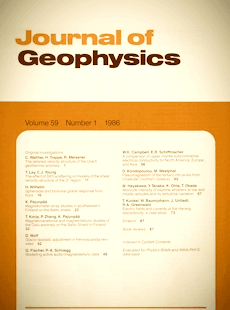Interactive high-resolution polarization analysis of broad-band seismograms
Article Sidebar

Vols. 1-18 (1924-1944), ISSN 0044-2801
Main Article Content
Abstract
In the laterally heterogeneous and anisotropic Earth the particle motions of seismic waves are three-dimensionally polarized. This paper presents a method for determining a local wave coordinate system using the zeros of some component operators in rotated systems. It is applicable to broad-band composite waveforms and offers higher precision and resolution for the determination of azimuth and incidence angle than the usual least-squares techniques. The algorithms have been implemented in an interactive program for preprocessing three-component digital recordings. In addition, the program allows the use of particle motion diagrams and component products for the determination of wave types, onset times and pulse durations. Its performance is demonstrated on regional and teleseismic events recorded at the European broad-band stations GRF (Grafenberg, West Germany), KRC (Kasperske Hory, Czechoslovakia) and KSP (Ksiaz, Poland).
 ARK: https://n2t.net/ark:/88439/y034913
ARK: https://n2t.net/ark:/88439/y034913
Permalink: https://geophysicsjournal.com/article/203
Article Details
References
Bamford, D. (1977) Seismic anisotropy - the state of the art. Geophys. J. 49:1-8
Brustle, W. (1985) Der Bruchvorgang im Erdbebenherd - Untersuchung ausgewahlter Erdbeben mit beobachteten und synthetischen Seismogrammen. Berichte des Instituts fur Meteorologie und Geophysik der Universitat. Frankfurt/M., Nr. 63
Chandra, U. (1972) Angles of incidence of S waves. Bull. Seismal. Soc. Am. 62:903-915
Cormier, V.F. (1984) The polarization of S waves in a heterogeneous isotropic earth model. J. Geophys. 56:20-23
Crampin, S.H. (1977) A review of the effects of anisotropic layering on the propagation of seismic waves. Geophys. J. 49:9-27
Crampin, S., Chesnokov, E.M., Hipkin, R.G. (1984) Seismic anisotropy - the state of the art: II. Geophys. J. 76:1-16
Harjes, H.-P., Seidl, D. (1978) Digital recording and analysis of broad-band seismic data at the Graefenberg (GRF)-array. J. Geophys. 44:511-523
Kanasewich, E.R. (1981) Time sequence analysis in geophysics, 3rd ed. Alberta: The University of Alberta Press
Keith, C.M., Crampin, S. (1977a) Seismic body waves in anisotropic media: reflection and refraction at a plane interface. Geophys. J. 49:181-208
Keith, C.M., Crampin, S. (1977b) Seismic body waves in anisotropic media: propagation through a layer. Geophys. J. 49:209-223
Keith, C.M., Crampin, S. (1977c) Seismic body waves in anisotropic media: synthetic seismograms. Geophys. J. 49:225-243
Kind, R. (1979) Observations of sPn from Swabian Alb earthquakes at the GRF array. J. Geophys. 45:337-340
Matsumura, S. (1981) Three-dimensional expression of seismic particle motions by the trajectory ellipsoid and its application to the seismic data observed in the Kanta district, Japan. J. Phys. Earth 29:221-239
Nuttli, O., Whitmore, J.D. (1961) An observational determination of the variation of the angle of incidence of P waves with the epicentral distance. Bull. Seismal. Soc. Am. 51:269-276
Pho, H.-T., Behe, L. (1972) Extended distances and angles of incidence of P waves. Bull. Seismal. Soc. Am. 62:885-902
Plešinger, A., Horalek, J. (1976) The seismic broadband recording and data processing system FBV /DPS and its seismological applications. J. Geophys. 42:201-217
Plešinger, A. (1981) Acquisition, processing and interpretation of broadband seismic data. In: Geophysical syntheses in Czechoslovakia, pp. 58-78. Bratislava: VEDA
Rademacher, H., Odom, R.I., Kind, R. (1983) The upper mantle structure under south-east Europe derived from broadband records of Greek earthquakes. J. Geophys. 52:7-13
Seidl, D. (1980) The simulation problem for broad-band seismograms. J. Geophys. 48:84-93
Seidl, D., Stammler, W. (1984) Restoration of broad-band seismograms (Part I). J. Geophys. 54:114-122











